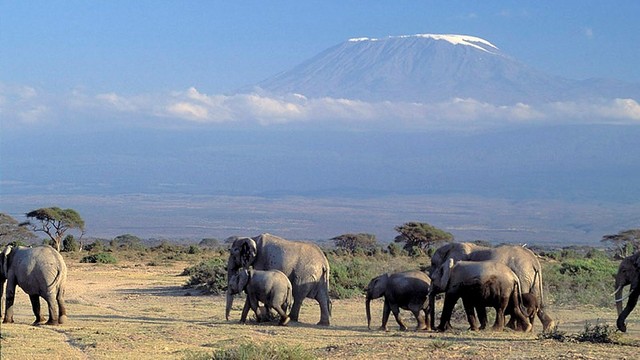2019 – the way forward is a Green Decent Work Guarantee
How can the world achieve a step change in the fight against climate change during 2019? IIED director Andrew Norton looks at the issues and suggests that a radical approach may hold the solution.


Villagers in India dig out a silted-up water tank as part of the Mahatma Gandhi National Rural Employment Act (Photo: McKay Savage, CC BY 2.0)
On the face of it 2018 was a deeply disturbing year for people and planet. Fossil fuel industries and petro-states were increasingly breaking cover and acting to gum up the works of the Paris Agreement. 2019 will see the US, Saudi Arabia and Russia joined by Brazil as an obstructive global force on environmental action – in this case driven as much by agribusiness as fossil fuel interests.
During 2018 the warning signs that climate and natural systems are under massive strain accelerated. The UK Meteorological Office has predicted that 2019 temperatures will come close to the global record set in 2016 – meaning that by the end of the year, 19 out of the 20 warmest years since records began in 1850 will have occurred since the year 2000.
The IPCC’s report on 1.5 degrees drove home how significant and damaging the half a degree Centigrade difference between the two Paris Agreement temperature goals would be. Evidence has also accumulated of alarming losses of global biodiversity. The 2018 Living Planet Index recorded an overall decline of 60% in species populations since 1970.
There were positive signs too. The alliance of progressive countries in favour of ambitious climate action rescued more from the UN climate talks at COP24 in Katowice than many thought possible. The world passed 1,000 GW of cumulative installed wind and solar power this year – ten years ago there was less than 8GW of solar. This remarkable rate of growth has been driven by rapid declines in cost.
New forms of climate activism through direct action have hit the headlines in rich countries, and the power of young voices as advocates for climate action was highlighted by 15-year-old Greta Thunberg’s remarkable speech at COP24. The fight against plastic pollution of the oceans has engaged people worldwide in environmental activism – and the world took important first steps towards establishing a framework for the legal protection of biodiversity in the high seas.
But we have not yet found the urgency in our politics that matches the urgency of the situation. We are used to thinking of the struggle for political justice as a matter of decades or more, and with good reason: entrenched interests with a stake in how things work don’t just give up and go away.
Where there are examples of climate leadership (such as in Costa Rica or the US state of California) they are rooted in particular histories, economies and politics. They are inspiring, but also lead us to pose an obvious question: how can they be replicated in places where civil society is not rooted in environmental concerns or where dirty business outguns clean business interests many times over?
And we don’t have time to waste. As the IPCC report made clear – every bit of warming counts, every single delay causes damage and makes achieving a safe future for people and planet that much harder. Where can the political tipping points be found to accelerate action?
The big lesson of 2018 is that to get political traction the green transition must work for social justice as well as for the environment. Climate policies that don’t address the needs of workers who are feeling squeezed (or worse, appear to make their lives harder) will produce a backlash – as we saw vividly in the recent ‘gilet jaunes’ protests in France, which were triggered by a proposed diesel fuel tax.
Motivating transformation
Technocratic solutions drawn from economic theory, such as carbon pricing, are unlikely to motivate a transformational movement. The insurgent rhetoric of the Green New Deal in the US (propelled into public debate by the youth-led Sunrise Movement) shows a way forward.
The concept is part of a particularly American discourse: during the Great Depression of the 1930s, US President Franklin D Roosevelt launched the ‘New Deal’: a huge programme of public works and job creation – transforming the country’s infrastructure and saving millions of Americans from destitution.
Today, the idea of a Green New Deal is capturing the imagination of young people: in the words of Democrat Congresswoman Alexandria Ocadio-Cortez, “This is going to be the Great Society, the moonshot, the civil rights movement of our generation.” There is of course a long way to go – while the idea is gaining support, US politics would have to change a lot for it to become feasible.
The Green New Deal makes a direct connection between tackling climate change and tackling inequality. A radical element is the proposal for a jobs guarantee – and these jobs would be geared to environmental goals such as rolling out renewable energy. History shows that when people are given rights they did not have before, and which they do not wish to give up, it becomes hard to roll back the progress made. So this is a powerful and resonant offer, which needs to find a global scale and a global language.
There are examples of large-scale employment guarantees that we can learn from. The biggest experience comes from India. IIED has been looking at lessons from implementation of the Mahatma Gandhi National Rural Employment Act.
MGNREGA is the largest social protection scheme in the world – reaching over 50 million households with direct cash-for-work transfers, provided on a basis of legal rights – everyone can claim a hundred days of paid work in every year. Furthermore, MGNREGA promotes climate resilience and good environmental stewardship at many levels, from strengthening the ability of households to cope with shocks, to local public works that improve the management of watersheds.
In 2019 we should be looking to make the connections between the ideas in the Green New Deal and the practical experience of social policy that supports the right to work, as demonstrated by MGNREGA. We should find ways to channel the labour that can be mobilised by a green work guarantee to the greatest possible effect – from supporting the roll out of low carbon energy to managing landscapes for storing carbon and preserving biodiversity.
A green decent work guarantee can also be a powerful tool to help societies cope with disruptions to the world of work from accelerating technological change. The nature of work is being transformed by digital technologies on a global scale. Well directed, it is a policy that can help equip people for the skills they will need in a changing world, adding to its potential to mobilise support for climate action.
We need a vision for a politics of climate action that incorporates a passion for social justice, promises a better future, and engages people at many levels – a green work guarantee can be a big part of that.



